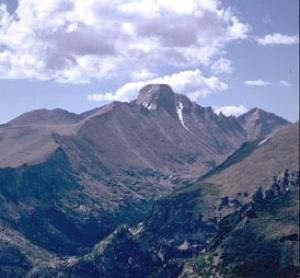A solitary hiker fell to his death from Longs Peak in Rocky Mountain National Park, officials reported Friday. Park officials were trying to determine whether the victim was a Colorado man who had failed to return from his trek up the 14,259-foot peak.
Longs Peak, one of Colorado's classic 14ers and the highest point in the national park, is a natural lure for mountaineers. While reaching the mountain's summit entails a technical climb most of the year, according to park annals, in summer there's a short window when the Keyhole Route can be accomplished without climbing aids. But that doesn't mean it's entirely without risk.
On Friday morning an off-duty park employee found the body of an unidentified male below the slightly more technical False Keyhole. "It appears that his fatal injuries were a result of a significant fall on the north side of Longs Peak," the park reported.
Rangers are investigating the incident and working with the Boulder County Coroner to identify the man. His body was flown from the Boulderfield at 4:30 p.m. Friday
At the same time, park staff were notified Thursday night that a 55-year-old Boulder, Colorado, man had not returned from his hike up Longs Peak as expected. A search was launched Friday morning for the man. Park officials have not yet determined if the two incidents are related.
Down through the years, many have died on the flanks of Longs Peak.
Here's some climbing history involving Longs Peak from the park:
Tragically, there are those who never left Longs Peak alive. A stone gazebo at the Keyhole formation displays a plaque memorializing Agnes Vaille, a well-known climber in the 1920s. The pioneer of numerous mountain routes in the Rockies, Vaille attempted the first winter ascent of the mountain's precipitous east face in January 1925. She and her climbing partner, Walter Kiener, succeeded after more than 24 hours of dangerous mountaineering through frigid blizzard conditions. While descending the North Face, Vaille fell 100 feet down the rock cliff, coming to a stop in a snowdrift. Her injuries were minor, but because of fatigue and hypothermia, Vaille was unable walk. Battling frostbite that would cost him toes and fingers, Kiener promptly summoned help. Vaille's rescuers arrived to find her dead from exposure.
Agnes Vaille and about 50 other climbers have lost their lives on Longs Peak. It is not a mountain tolerant of the unprepared. But hiking and technical climbing on the mountain are exciting and rewarding experiences. And they are comparatively safe if common-sense safety principles are applied. Give yourself time to acclimate to the altitude before attempting to climb. Carry all the hiking essentials. Use caution when ascending or descending steep areas. Don't be afraid to back down when bad weather threatens. Enjoy your adventure.




Comments
For the brave hikers who reach too the stars, they are not forgotten. The abiltity too experience solitude and accomplish a hikers dream..priceless. Although there is risk, these brave souls will never be forgotten. In short memory of the most recent hiker.....may u never be forgotten...prayers go out....
Condolences to the family of the man that fell and died yesterday while descending from the summit. We were there, at the Keyhole and actually made the phone call to 911 and the national park emergency people immediately after it happened. The mood at the keyhole was somber as people passed through and learned of the accident and death.